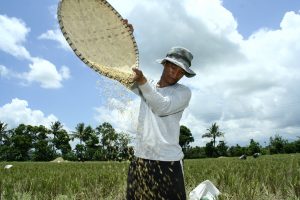In its response to COVID-19 the Philippines mounted a two-pronged relief effort on the economic front. The central bank lowered its benchmark interest rate to 2 percent and expects to keep rates low through 2022 in order to increase liquidity in the financial system. On the fiscal side, the legislature passed a pair of bills designed to prop up the healthcare system, provide cash to low-income households and extend credit to small businesses and hard-hit sectors.
Known as Bayanihan 1 and 2, these pieces of legislation deserve a closer look, as together they form the backbone of the state’s economic rescue efforts and confer President Rodrigo Duterte with expanded powers to combat the emergency. Bayanihan 1 was passed quickly in late March 2020 as the COVID-19 situation was rapidly developing.
The bill gave Duterte the authority to repurpose unused or unallocated funds from the existing 2020 national budget and apply them toward priority areas specified in the legislation. The largest component was a subsidy of up to 8,000 pesos ($166) per month to 18 million low-income households. Between March and November 2020 the Department of Social Welfare and Development received 217.4 billion pesos ($4.5 billion) for these cash disbursements.
There were some concerns about this approach, as the Congressional Policy and Budget Research Department noted in a May 2020 circular: “Ideally no public funds will be spent other than what the General Appropriation Act provides for…. [however] the preparation of the FY 2020 National Expenditure Program (back in 2019) has not taken into account any potential occurrence of a pandemic.” The logic of funding a pandemic relief effort by squeezing a budget not intended for that purpose is indeed questionable, and the bill contained other dubious provisions such as a possible two-month jail sentence for anyone “perpetrating or spreading false information regarding the COVID-19 crisis.”
Nonetheless, the legislation helped to blunt the worst of the pandemic by getting cash out to the most vulnerable members of society, and it set the stage for Bayanihan 2, which was signed into law in September of 2020. This legislation blocks out 140 billion pesos ($2.9 billion) for immediate disbursement and a 25 billion peso ($520 million) standby fund. It includes 53 billion pesos ($1.1 billion) for healthcare, and more targeted aid for other sectors.
At the same time, 39.5 billion pesos ($822 million) were allocated for capital injections to government financial institutions with the lion’s share of 18.47 billion pesos ($384 million) going to the Land Bank of the Philippines, the largest state-owned lender and one with a specific mandate to extend credit to agricultural borrowers and small businesses. 24 billion pesos ($500 million) in cash and loan subsidies were earmarked for qualified businesses in agriculture and fishing, while the standby fund contains an additional 9 billion ($187 million) for the Land Bank. That means over 30 percent of Bayanihan 2’s total 165 billion peso ($3.4 billion) price tag is intended for the agricultural and fisheries sector.
My take-away from the design of Bayanihan 1 and 2 is that the state does not want to borrow a lot of money in order to fund its economic relief efforts. Unlike Indonesia, where the central bank has been monetizing government debt so the state can run bigger deficits, the Philippines has gone to some length to squeeze all the mileage it can out of funds that have already been budgeted.
Another interesting point is that in addition to the healthcare sector and low-income households, the big aid recipient is agriculture. This might seem a bit puzzling, as agriculture has been shrinking as a share of GDP for the last two decades, accounting for only 8.8 percent of output in 2019. But it snaps into sharper focus when looking at Asian Development Bank data showing that agriculture and fishing employ some 9.7 million people. While it may not be the most productive, it is the largest sector in terms of employment, supporting about 23 percent of the workforce and therefore keeping it viable is essential public policy.
This is why the government has taken pains to ensure the Land Bank is adequately capitalized. As of August 2020, the bank had 764 billion pesos ($15.9 billion) in loans outstanding to priority sectors such as agriculture, housing and education, more than the entire amount allocated to Bayanihan 1 and 2 combined. By shoring up the balance sheets of big state lenders the government hopes loans in critical sectors like agriculture can be rolled over until the crisis resolves without busting the budget. Whether these efforts will prove sufficient remains to be seen, but the logic of Bayanihan 1 and 2 is at least clear enough.

































